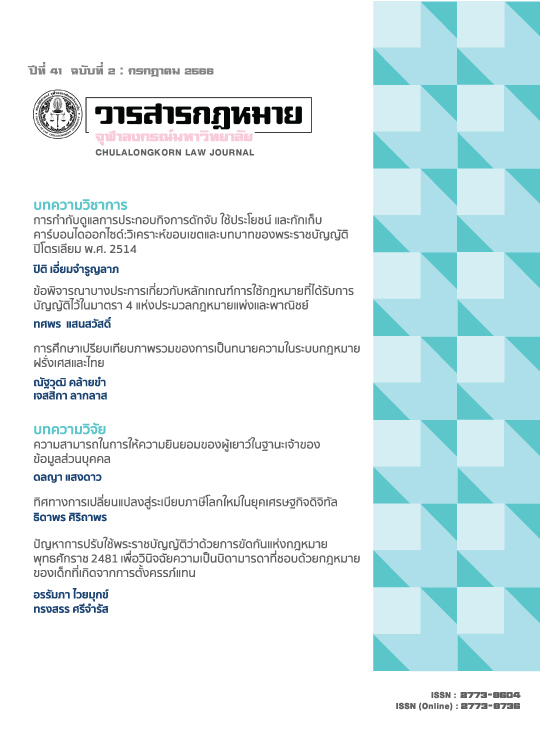ทิศทางการเปลี่ยนแปลงสู่ระเบียบภาษีโลกใหม่ในยุคเศรษฐกิจดิจิทัล
Main Article Content
บทคัดย่อ
การพัฒนาเทคโนโลยีดิจิทัลในหลายด้านอย่างฉับพลัน (disruptive technology) ทำให้โลกก้าวเข้าสู่ยุคเศรษฐกิจดิจิทัล (digital economy) อย่างเต็มรูปแบบ โดยมีระบบเทคโนโลยีดิจิทัลเป็นแกนหลักที่ขับเคลื่อนระบบเศรษฐกิจ พัฒนาการของระบบเศรษฐกิจดิจิทัลดังกล่าวย่อมส่งผลกระทบต่อระบบเศรษฐกิจและสังคมอย่างกว้างขวางในหลากหลายมิติ รวมถึงมิติของการจัดเก็บภาษีอากร จึงทำให้เกิดประเด็นว่าหลักการจัดเก็บภาษีอากรที่ใช้อยู่ในปัจจุบันในประเทศต่าง ๆ โดยเฉพาะการจัดเก็บภาษีจากกิจการข้ามชาติ มีลักษณะที่ล้าสมัย และไม่สามารถรองรับสภาพแวดล้อมที่เปลี่ยนแปลงไปอย่างฉับพลัน (disruptive environment) ในยุคเศรษฐกิจดิจิทัลได้ ดังนั้นในช่วงทศวรรษที่ผ่านมาจึงเกิดกระแสการปฏิรูปหลักการภาษีอากร (tax reform) ขึ้นทั่วโลก เพื่อให้การจัดเก็บภาษีอากรในยุคเศรษฐกิจดิจิทัลเป็นไปอย่างเหมาะสม งานวิจัยนี้จึงมุ่งศึกษาถึงกระแสการปฏิรูปหลักการภาษีอากรดังกล่าวที่ทำให้เกิดการบูรณาการด้านภาษี (tax harmonisation) ทั้งนี้เมื่อศึกษาถึงการเปลี่ยนแปลงด้านภาษีที่เกิดขึ้นทั้งในระดับประเทศ (national level) ระดับภูมิภาค (regional level) และระดับสากล (global level) แล้วพบว่ากระแสการปฏิรูปและการบูรณาการดังกล่าวมีทิศทางการเปลี่ยนแปลงเป็นวิถีสู่ระเบียบภาษีโลกใหม่ (new world tax order) ที่มุ่งสร้างปทัสถานสากลด้านภาษี (global tax norms) มารองรับการจัดเก็บภาษีอากรในยุคเศรษฐกิจดิจิทัลให้เป็นไปอย่างสอดคล้องและเหมาะสม งานวิจัยนี้ได้ทำการวิเคราะห์ทิศทางการเปลี่ยนแปลงดังกล่าว และได้นำเสนอว่าถึงแม้กระแสการปฏิรูปและการบูรณาการด้านภาษีดังกล่าวจะมีวิถีแห่งการเปลี่ยนแปลงไปสู่ระเบียบภาษีโลกใหม่ แต่ก็ยังพัฒนาไปไม่ถึงขั้นการกำหนดหลักเกณฑ์ที่บังคับใช้ร่วมกันเป็นหนึ่งเดียวอย่างเป็นเอกรูป (unification) ผ่านองค์กรเหนือรัฐ (supranationalism) ทั้งนี้ทิศทางการเปลี่ยนแปลงในปัจจุบันยังคงอยู่ในลักษณะของความร่วมมือระหว่างรัฐ (intergovernmental approach) ที่มีมาตรการบูรณาการที่เกี่ยวข้องหลายระดับขั้นการบูรณาการ (degree) ทั้งในรูปแบบทวิภาคี (bilateral approach) และรูปแบบพหุภาคี (multilateral approach) โดยดำเนินไปแบบผสมผสานควบคู่กับการใช้มาตรการฝ่ายเดียว (unilateral approach) โดยอาศัยเครื่องมือการบูรณาการทั้งที่อยู่ในรูปแบบ “ไม้แข็ง” ที่มีผลผูกพันตามกฎหมาย (hard law) และในรูปแบบ “ไม้นวม” ที่ไม่ได้มีผลผูกพันทางกฎหมาย (soft law) ทั้งนี้แนวทางการบูรณาการระเบียบภาษีโลกใหม่จะเน้นให้ความสำคัญกับมาตรการแบบพหุภาคี (multilatearl approach) มากกว่ายุคดั้งเดิมอย่างมีนัยสำคัญ นอกจากนี้งานวิจัยนี้ได้นำเสนอว่าทิศทางการเปลี่ยนแปลงสู่ระเบียบภาษีโลกใหม่จากกระแสปฏิรูปและการบูรณาการด้านภาษีดังกล่าวส่งผลกระทบอย่างมีนัยสำคัญต่อเขตอำนาจรัฐในการจัดเก็บภาษี (tax jurisdiction) รวมถึงอำนาจอธิปไตยของรัฐในการจัดเก็บภาษี (national tax sovereignty) ด้วย ซึ่งอาจก่อให้เกิดทั้งจุดแข็งและจุดอ่อนอันนำไปสู่ปัญหาอุปสรรคและโอกาสที่แตกต่างกันไปในแต่ละประเทศ จึงควรศึกษาวิจัยสืบเนื่องต่อไปในอนาคต
Article Details

อนุญาตภายใต้เงื่อนไข Creative Commons Attribution-NonCommercial-NoDerivatives 4.0 International License.
ลิขสิทธิ์และเนื้อหาในเว็บไซต์ของวารสารกฎหมาย (รวมถึง โดยไม่จำกัดเฉพาะ เนื้อหา รหัสคอมพิวเตอร์ งานศิลป์ ภาพถ่าย รูปภาพ ดนตรีกรรม โสตทัศนวัสดุ) เป็นกรรมสิทธิ์ของวารสารกฎหมาย และผู้ได้รับการโอนสิทธิทุกราย
1. วารสารกฎหมาย ให้อนุญาตให้คุณใช้สิทธิอันไม่เฉพาะเจาะจงที่สามารถถูกถอนเมื่อใดก็ได้ โดยไม่มีค่าใช้จ่าย ในการ
- เยี่ยมชมเว็บไซต์และเอกสารในเว็บไซต์นี้ จากคอมพิวเตอร์หรือเครื่องมือสื่อสารผ่านเว็บบราวเซอร์
- คัดลอกและจัดเก็บเว็บไซต์และเอกสารในเว็บไซต์นี้บนลงคอมพิวเตอร์ของคุณผ่านระบบความจำ cache
- สั่งพิมพ์เอกสารจากเว็บไซต์นี้สำหรับการใช้ส่วนตัวของคุณ
- ผลงานที่ได้รับการตีพิมพ์โดยวารสารกฎหมาย จุฬาลงกรณ์มหาวิทยาลัย ถูกคุ้มครองภายใต้ Creative Commons Attribution 4.0 International License ซึ่งอนุญาตให้ทุกคนสามารถคัดลอก แจกจ่าย ดัดแปลง ส่งต่อ ผลงานได้ ก็ต่อเมื่อผลงานและแหล่งข้อมูลได้รับการอ้างอิงอย่างเหมาะสม
2. วารสารกฎหมาย จุฬาลงกรณ์มหาวิทยาลัย สงวนสิทธิ์ไม่อนุญาตให้คุณใช้สิทธิอื่นใดที่เกี่ยวข้องกับเว็บไซต์และเอกสารบนเว็บไซต์นี้ เช่น การคัดลอก ดัดแปลง เปลี่ยนแปลง ส่งต่อ ตีพิมพ์ แจกจ่าย เผยแพร่ จัดแสดงในที่สาธารณะ ไม่ว่าจะในรูปแบบใดก็ตาม ซึ่งเว็บไซต์หรือเอกสารบนเว็บไซต์ โดยไม่อ้างอิงถึงแหล่งข้อมูลหรือโดยไม่ได้รับอนุญาตเป็นลายลักษณ์อักษรจากวารสารกฎหมาย จุฬาลงกรณ์มหาวิทยาลัย
3. คุณอาจขออนุญาตที่จะใช้เอกสารอันมีลิขสิทธิ์บนเว็บไซต์นี้โดยการเขียนอีเมลล์มายัง journal@law.chula.ac.th
4. วารสารกฎหมาย จุฬาลงกรณ์มหาวิทยาลัย เข้มงวดกับการคุ้มครองลิขสิทธิ์อย่างมาก หากวารสารกฎหมาย จุฬาลงกรณ์มหาวิทยาลัยพบว่าคุณได้ใช้เอกสารอันมีลิขสิทธิ์บนเว็บไซต์นี้โดยไม่ถูกต้องตามการอนุญาตให้ใช้สิทธิ ดังที่กล่าวไปข้างต้น วารสารกฎหมาย จุฬาลงกรณ์มหาวิทยาลัยอาจดำเนินคดีตามกฎหมายต่อคุณได้ เพื่อเรียกร้องค่าเสียหายที่เป็นตัวเงินและคำขอชั่วคราวให้คุณหยุดการใช้เอกสารดังกล่าว ทั้งนี้ คุณอาจถูกสั่งให้ชดใช้ค่าใช้จ่ายใดๆ ที่เกี่ยวข้องกับการดำเนินการตามกฎหมายนี้
หากคุณพบเห็นการใช้เอกสารอันมีลิขสิทธิ์ของวารสารกฎหมาย จุฬาลงกรณ์มหาวิทยาลัย ที่ขัดหรืออาจขัดต่อการอนุญาตให้ใช้สิทธิดังที่ได้กล่าวไปข้างต้น โดยเชื่อว่าได้ละเมิดลิขสิทธิ์ของคุณหรือของผู้อื่น สามารถร้องเรียนมาได้ที่ journal@law.chula.ac.th


